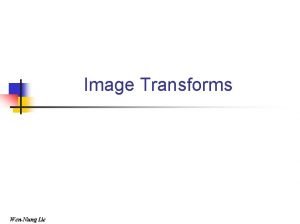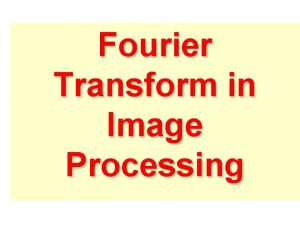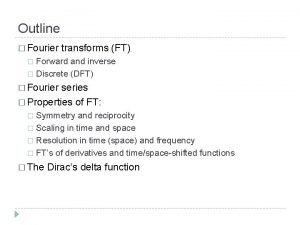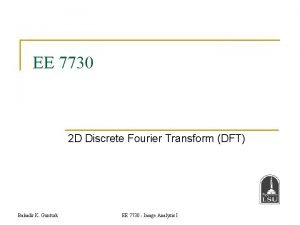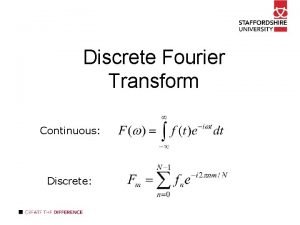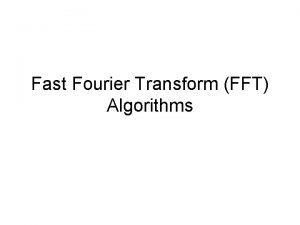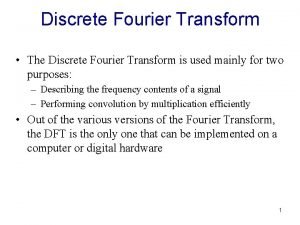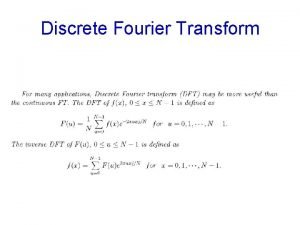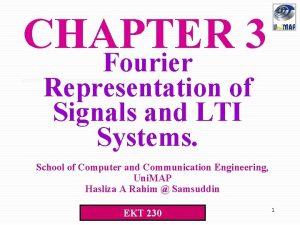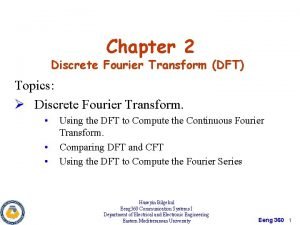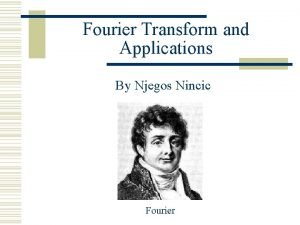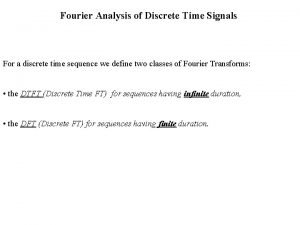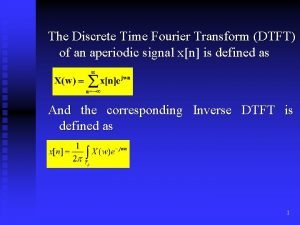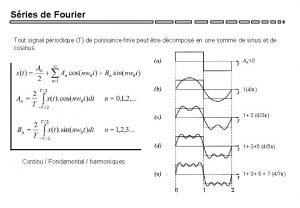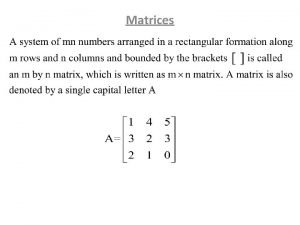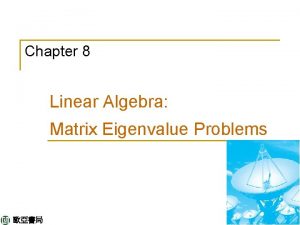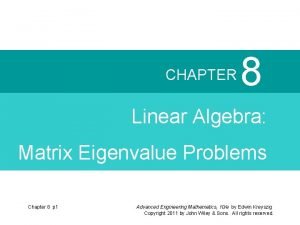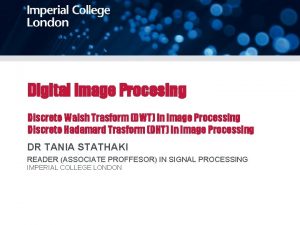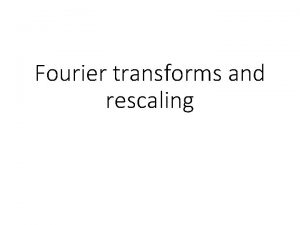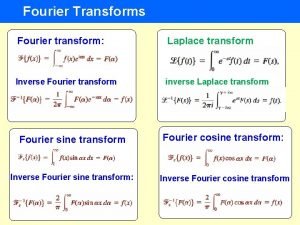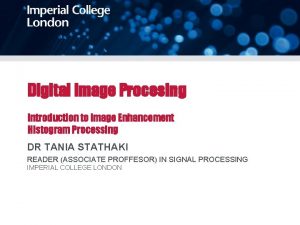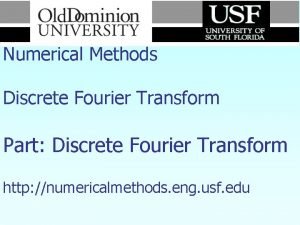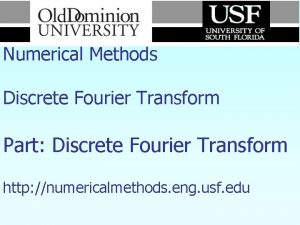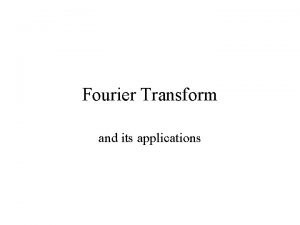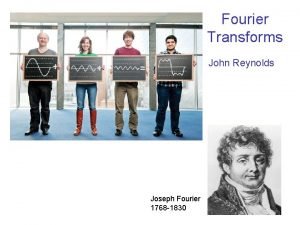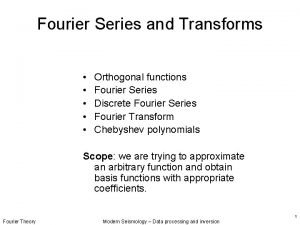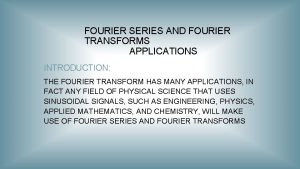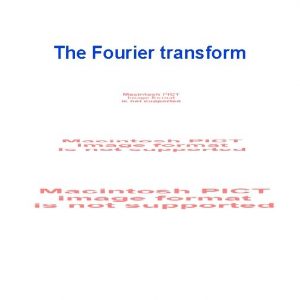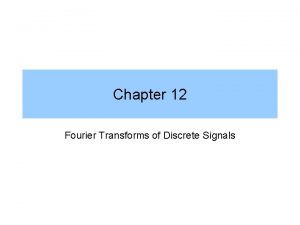Digital Image Procesing Unitary Transforms Discrete Fourier Trasform











































- Slides: 43

Digital Image Procesing Unitary Transforms Discrete Fourier Trasform (DFT) in Image Processing DR TANIA STATHAKI READER (ASSOCIATE PROFFESOR) IN SIGNAL PROCESSING IMPERIAL COLLEGE LONDON

1 -D Signal Transforms Scalar form Matrix form

1 -D Signal Transforms-Remember the 1 -D DFT General form DFT

1 -D Inverse Signal Transforms-General Form Scalar form Matrix form

1 -D Inverse Signal Transforms-Remember the 1 D DFT General form Inverse DFT

1 -D Unitary Transforms Matrix form

Signal Reconstruction

Why do we use Image Transforms? Often, image processing tasks are best performed in a domain other than the spatial domain. Key steps: • Transform the image • Carry the task(s) of interest in the transformed domain. • Apply inverse transform to return to the spatial domain.

2 -D (Image) Transforms-General Form

2 -D (Image) Transforms-Special Cases Separable Symmetric

2 -D (Image) Transforms-Special Cases (cont. ) Separable and Symmetric Separable, Symmetric and Unitary

Energy Preservation 1 -D 2 -D

Energy Compaction • Most of the energy of the original data is concentrated in only a few transform coefficients, which are placed close to the origin; remaining coefficients have small values. • This property facilitate compression of the original image.

Let’s talk about DFT in images: Why is it useful? • It is easier for removing undesirable frequencies. • It is faster to perform certain operations in the frequency domain than in the spatial domain. • The transform is independent of the signal.

Example: Removing undesirable frequencies Example of removing a high frequency using the transform domain noisy signal frequencies Result after removing high frequencies

How do frequencies show up in an image? • Low frequencies correspond to slowly varying information (e. g. , continuous surface). • High frequencies correspond to quickly varying information (e. g. , edges) Original Image Low-passed version

2 -D Discrete Fourier Transform • It is separable, symmetric and unitary • It results in a sequence of two 1 -D DFT operations (prove this)

Visualizing DFT • • • The dynamic range of F(u, v) is typically very large Small values are not distinguishable We apply a logarithmic transformation to enhance small values. original image before transformation after transformation

Amplitude and Log of the Amplitude

Amplitude and Log of the Amplitude

Original Image and Log of the Amplitude

DFT properties: Separability

DFT properties: Separability

DFT properties: Separability

DFT properties: Separability The DFT and its inverse are periodic.

DFT properties: Symmetry If F(u, v) is real, then

DFT properties: Translation in spatial domain: Translation in frequency domain:

DFT properties: Translation Warning: to show a full period, we need to translate the origin of the transform at

DFT properties: Translation

DFT properties: Translation without translation after translation

DFT properties: Rotation

DFT properties: Addition and Multiplication

DFT properties: Average value of the signal

Original Image Fourier Amplitude Fourier Phase

Magnitude and Phase of DFT What is more important? magnitude phase Hint: use inverse DFT to reconstruct the image using magnitude or phase only information

Magnitude and Phase of DFT Reconstructed image using magnitude only (i. e. , magnitude determines the contribution of each component!) Reconstructed image using phase only (i. e. , phase determines which components are present!)

Magnitude and Phase of DFT

Low pass filtering using DFT

High pass filtering using DFT

Experiment: Verify the importance of phase in images

Reconstruction from phase of one image and amplitude of the other phase of cameraman amplitude of grasshopper phase of grasshopper amplitude of cameraman

Experiment: Verify the importance of phase in images

Reconstruction from phase of one image and amplitude of the other phase of buffalo amplitude of rocks phase of rocks amplitude of buffalo
 Walsh transform in digital image processing
Walsh transform in digital image processing Uu
Uu Top-down processing vs bottom-up processing
Top-down processing vs bottom-up processing Top-down vs bottom-up processing
Top-down vs bottom-up processing A function
A function Image transforms
Image transforms Forward fourier transform
Forward fourier transform Discrete fourier transform
Discrete fourier transform Discrete fourier transform
Discrete fourier transform Dft vs fft
Dft vs fft Discrete time fourier series
Discrete time fourier series Dft
Dft 2d discrete fourier transform
2d discrete fourier transform Dtft representation of
Dtft representation of Discrete fourier transform
Discrete fourier transform Application of discrete fourier transform
Application of discrete fourier transform Fourier analysis of discrete time signals
Fourier analysis of discrete time signals Discrete time fourier transform
Discrete time fourier transform Fourier transform formula
Fourier transform formula Spectre signal echantillonné
Spectre signal echantillonné Translate
Translate Noise
Noise Image compression models in digital image processing
Image compression models in digital image processing Key stages in digital image processing
Key stages in digital image processing Analog image and digital image
Analog image and digital image Subjective fidelity criteria in digital image processing
Subjective fidelity criteria in digital image processing Image sharpening and restoration
Image sharpening and restoration Image geometry in digital image processing
Image geometry in digital image processing Image formation model in digital image processing ppt
Image formation model in digital image processing ppt Imtransform matlab
Imtransform matlab Noise
Noise Confederation system of government
Confederation system of government Unitary form organizational structure
Unitary form organizational structure Confederal system diagram
Confederal system diagram Is orthogonal
Is orthogonal What is unit elastic
What is unit elastic What is a unitary system of government
What is a unitary system of government Unitary systems
Unitary systems Elasticity of supply
Elasticity of supply Comparing asian governments
Comparing asian governments Hermitian matrix and skew hermitian matrix
Hermitian matrix and skew hermitian matrix Eigenvalue of 2x2 matrix
Eigenvalue of 2x2 matrix Unitary form organizational structure
Unitary form organizational structure Unitary form organizational structure
Unitary form organizational structure

